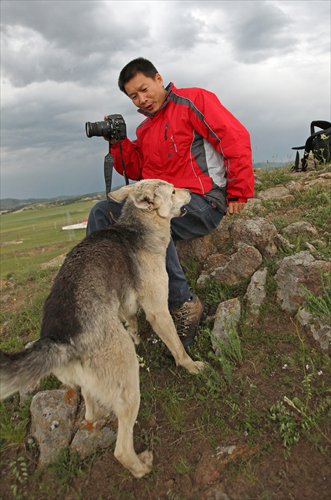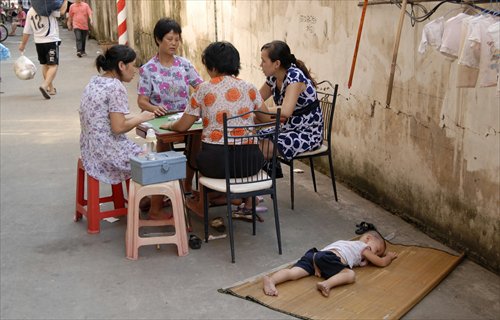HOME >> CHINA
Zhan Youbing trains his camera on a neglected social group
By Liang Chen Source:Global Times Published: 2015-1-23 5:03:01

Zhan Youbing Photo: Courtesy of Zhan Yuobing

Migrant workers play mahjong in Dongguan, South China's Guangdong Province.

Children of migrant workers play games in Dongguan. Photo: Zhan Youbing
For the past nine years, Zhan Youbing, 41, has focused on doing only one thing: taking photos of migrant workers.Zhan, who used to be a migrant worker himself, bought a camera in 2002 and has been taking photos ever since. His commitment to photography, as he puts it, is due to a strong sense of insecurity that continues to haunt him even to this day.
"Most migrant workers are like rootless duckweed. We left our hometowns and fought for a better life in big cities. We have no sense of security," Zhan, with his camera draped around his neck as always, told the Global Times.
At first he wanted to show his family back home his life in the cities but later he thought that mastering the art of photography could increase his sense of security and help him become more competitive in the labor market.
This sense of insecurity pushed him to success. So far, he has taken over 400,000 photos of migrant workers.
In November, Zhan published his first book, titled I Am a Migrant Worker, which drew a great deal of attention among the public due to the insider's view it offered into the lives of migrant workers. The book also became known as the first of its kind to fully delve into the lives of this segment of society.
Tough times
Born in Xiangfan, Central China's Hubei Province, Zhan was a soldier and left the army in 1995. After this, he left home to work in South China's Guangdong Province, at a time when the first batch of migrant workers in China started to work in the cities.
At that time, the labor market was fiercely competitive in Guangdong. It was common that two or three hundred people would compete for 10 jobs.
Like other migrant workers, Zhan worked hard to get a job. Finally, he beat over 100 competitors and found employment as a factory guard after doing 102 push-ups in a row.
Despite his struggles, Zhan wanted to show his life in the metropolis to his parents at home. "Describing life in the city to my parents through words didn't work well, so I began to take photos," Zhan said.
In 2002, Zhan spent 1,400 yuan, then the equivalent of one month's salary, on a second-hand Nikon camera, and started to take photos. At the very beginning, he wanted to show the best aspects of life and took a large number of scenic snapshots.
By chance, he met a documentary photographer who influenced him to take a new direction. It was then that he began to focus on migrant workers.
Almost every day, he would spend hours hanging around factories, dormitories, bus stations, labor markets and book stalls, capturing the daily routines of migrant workers.
"I want to record the lives of migrant workers, their lives and struggles," he said.
In 2006, he took lessons at a local photography school for two months to improve his skills. By then, he had also started to post his photos online, which allowed him to make friends with several photographers.
Tang Shouxin, deputy director of the Chang'an Photography Association, was one of them. Tang has been friends with Zhan for over a decade and was impressed by his persistence and hard work.
"He would use every opportunity to learn from other photographers. He is modest and devoted to his job," Tang said.
"It is a difficult thing to focus on one group for nine years straight. Zhan did this, and his help in documenting the history of migrant workers, a group that is neglected, has been invaluable," Tang told the Global Times.
Eye on the future
He may also be one of the most diligent photographers around. Besides taking photos, Tang conducted interviews with migrant workers and documented their personal stories. He believes that in the future, the personal stories of migrant workers can document the changes seen in Chinese society over the last two decades.
He has also collected the personal belongings of migrant workers, including name tags, work licenses and personal items. So far, he has collected four boxes of objects. He hopes that one day, these objects can be put on display in a museum for migrant workers.
"These ordinary objects can reflect history. It is very meaningful for us to record the lives of migrant workers," Zhan said.
He has a specific interest in photographing hands of migrant workers, most of which are covered with calluses due to years of hard toil.
Occasionally, his photos have resulted in controversy. For instance, he took a series of photos of a migrant worker couple canoodling on a public bench. These photos drew criticism on the Internet, with some criticizing the couple for "acting improperly in a public area."
Zhan rejected the criticism. "It reflected the long-term social problem of migrant workers lacking private space, as they have to live together in dormitories," Zhan said.
Zhan argued that migrant workers need care and support from the public, rather than misunderstanding and discrimination.
In a way, he has become an advocate for migrant workers.
Now, Zhan has turned his passion into a job and is a photographer in a local magazine.
Despite all these accolades, he still wants to fix his lens on migrant workers.
He plans to publish at least four books about their lives, such as portraits of migrant workers, photos of their belongings, industrial zones and family stories.
Currently, he is also cooperating with some local NGOs, voluntarily participating in projects concerning the rights of migrant workers.
"I am a migrant worker, and this will never change," Zhan said.
Newspaper headline: Migrant workers in focus
Posted in: Profile